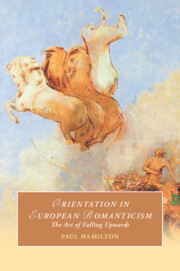79 results
13 - Evidencing Conversation-Analytic Claims: How Participants Orient to Social Action
- from Part IV - Evidence
-
- Book:
- The Cambridge Handbook of Methods in Conversation Analysis
- Published online:
- 06 December 2024
- Print publication:
- 05 December 2024, pp 315-355
-
- Chapter
- Export citation
Biotite Alteration in Deeply Weathered Granite. II. The Oriented Growth of Secondary Minerals
-
- Journal:
- Clays and Clay Minerals / Volume 27 / Issue 5 / October 1979
- Published online by Cambridge University Press:
- 01 July 2024, pp. 361-367
-
- Article
-
- You have access
- Export citation
Use of X-ray Powder Diffraction and Linear Dichroism Methods to Study the Orientation of Montmorillonite Clay Particles
-
- Journal:
- Clays and Clay Minerals / Volume 36 / Issue 5 / October 1988
- Published online by Cambridge University Press:
- 02 April 2024, pp. 476-479
-
- Article
-
- You have access
- Export citation
The Lorentz-Polarization Factor and Preferred Orientation in Oriented Clay Aggregates
-
- Journal:
- Clays and Clay Minerals / Volume 34 / Issue 4 / August 1986
- Published online by Cambridge University Press:
- 02 April 2024, pp. 359-367
-
- Article
-
- You have access
- Export citation
Convenient Technique for Estimating Smectite Layer Percentage in Randomly Interstratified Illite/Smectite Minerals
-
- Journal:
- Clays and Clay Minerals / Volume 37 / Issue 3 / June 1989
- Published online by Cambridge University Press:
- 02 April 2024, pp. 227-234
-
- Article
-
- You have access
- Export citation
Deuterium Nuclear Magnetic Resonance Studies of Water Molecules Restrained by Their Proximity to a Clay Surface
-
- Journal:
- Clays and Clay Minerals / Volume 37 / Issue 5 / October 1989
- Published online by Cambridge University Press:
- 02 April 2024, pp. 403-408
-
- Article
-
- You have access
- Export citation
Intercalation of Salts of Fatty Acids into Kaolinite
-
- Journal:
- Clays and Clay Minerals / Volume 38 / Issue 1 / February 1990
- Published online by Cambridge University Press:
- 02 April 2024, pp. 29-32
-
- Article
-
- You have access
- Export citation
7 - Thomas Wizenmann
- from Part II - Between the Critiques
-
- Book:
- Kant's <i>Critique of Practical Reason</i>
- Published online:
- 31 January 2025
- Print publication:
- 28 March 2024, pp 165-168
-
- Chapter
- Export citation
9 - Disorders of Consciousness
-
- Book:
- Fish's Clinical Psychopathology
- Published online:
- 12 January 2024
- Print publication:
- 01 February 2024, pp 103-107
-
- Chapter
- Export citation
Adsorption of Dinitrophenol Herbicides From Water by Montmorillonites
-
- Journal:
- Clays and Clay Minerals / Volume 50 / Issue 1 / February 2002
- Published online by Cambridge University Press:
- 01 January 2024, pp. 25-34
-
- Article
-
- You have access
- Export citation
4 - Time in Space
-
- Book:
- Time, Metaphor, and Language
- Published online:
- 09 November 2023
- Print publication:
- 23 November 2023, pp 50-81
-
- Chapter
- Export citation
4 - Anthrozoology and Visitor Behaviour
-
- Book:
- Zoo Studies
- Published online:
- 12 May 2023
- Print publication:
- 01 June 2023, pp 71-96
-
- Chapter
- Export citation
Chapter 3 - Attention, Judgement and Other Work
-
- Book:
- Merleau-Ponty's <i>Phenomenology of Perception</i>
- Published online:
- 03 November 2022
- Print publication:
- 17 November 2022, pp 53-77
-
- Chapter
- Export citation

Orientation in European Romanticism
- The Art of Falling Upwards
-
- Published online:
- 13 October 2022
- Print publication:
- 20 October 2022
The Böckenförde Dictum, Aristotle’s Koinōnia, and the Debate on the Future of Europe - Discussed: Religion, Law, and Democracy: Selected Writings. By Ernst-Wolfgang Böckenförde. Edited by Mirjam Künkler and Tine Stein. Translated by Thomas Dunlap. Oxford: Oxford University Press, 2020. Pp. 480. $65.00 (cloth); Oxford Scholarship Online by subscription (digital). ISBN: 9780198818632. DOI: https://doi.org/10.1093/oso/9780198818632.001.0001.
-
- Journal:
- Journal of Law and Religion / Volume 37 / Issue 3 / September 2022
- Published online by Cambridge University Press:
- 28 September 2022, pp. 547-559
-
- Article
- Export citation
Development and implementation of a paediatric cardiac intensive care advanced practice provider curriculum
-
- Journal:
- Cardiology in the Young / Volume 33 / Issue 8 / August 2023
- Published online by Cambridge University Press:
- 05 August 2022, pp. 1288-1295
-
- Article
- Export citation
14 - Inquiry Approach and Phases of Learning in Undergraduate Research
- from Part II.2 - Key Measures for the Implementation of Undergraduate Research
-
-
- Book:
- The Cambridge Handbook of Undergraduate Research
- Published online:
- 11 August 2022
- Print publication:
- 07 July 2022, pp 149-157
-
- Chapter
- Export citation
Conclusion
- from Part III - The Task of Philosophy
-
- Book:
- Cassirer and Heidegger in Davos
- Published online:
- 05 May 2022
- Print publication:
- 19 May 2022, pp 245-248
-
- Chapter
- Export citation
7 - Infinity or Finitude
- from Part II - ‘What Is the Human Being?’
-
- Book:
- Cassirer and Heidegger in Davos
- Published online:
- 05 May 2022
- Print publication:
- 19 May 2022, pp 153-176
-
- Chapter
- Export citation
10 - Enlightenment or Therapy
- from Part III - The Task of Philosophy
-
- Book:
- Cassirer and Heidegger in Davos
- Published online:
- 05 May 2022
- Print publication:
- 19 May 2022, pp 220-244
-
- Chapter
- Export citation

